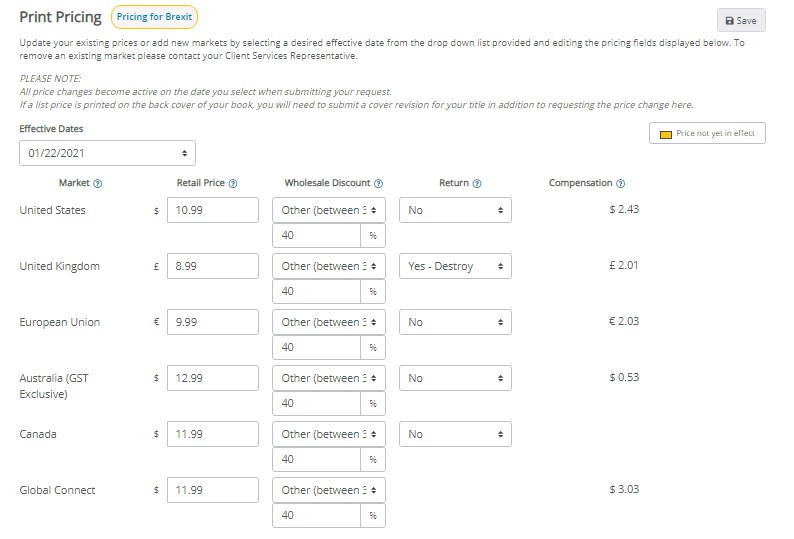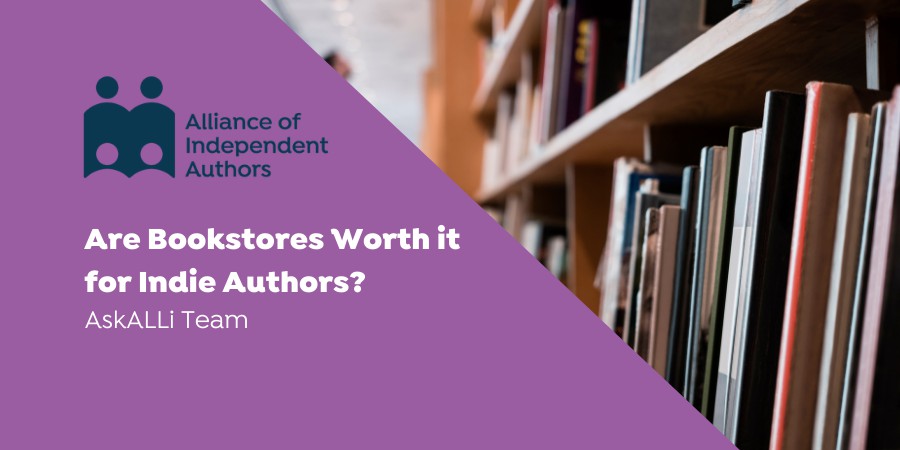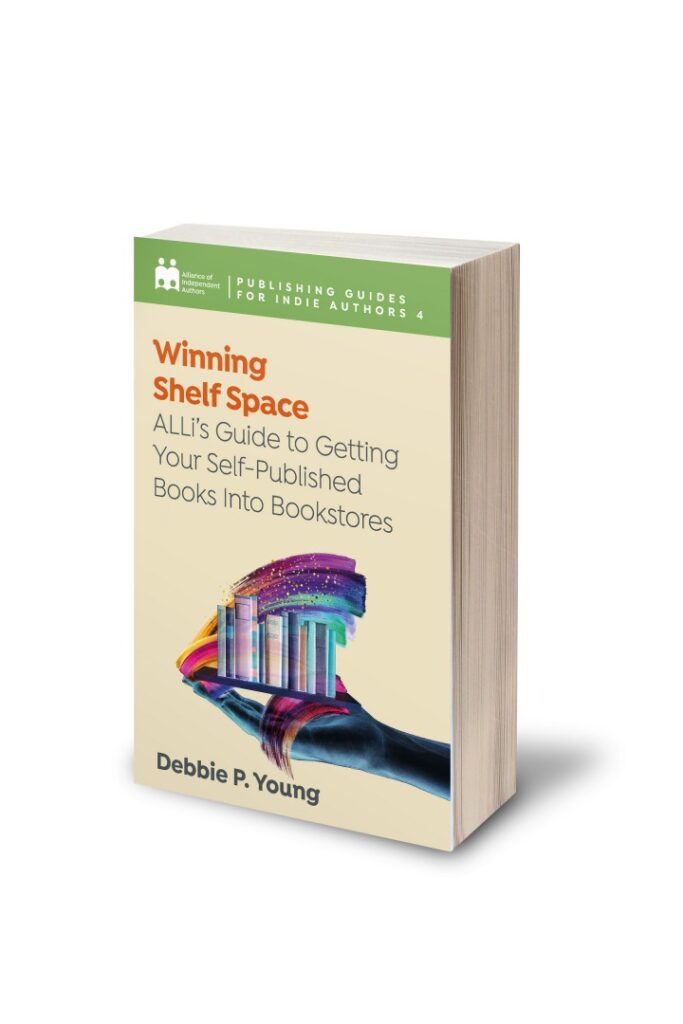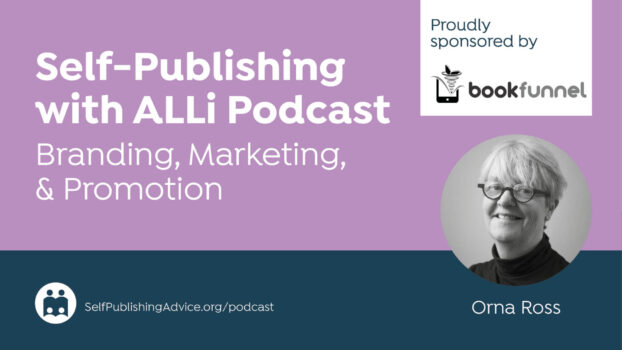For most indie authors writing today, traditional bookstores in the mall and on the high street fueled our writing ambitions and our love of reading as children. Most writers would be thrilled to see their books on display in bookstore windows, display tables and shelves. Despite the rise and rise of ebooks and audiobooks, and especially during the boom in online buying during the Covid-19 pandemic, physical bookstores are still a significant marketplace for readers to discover and buy books. However it is much more challenging for the indie author to sell books via bookstores than online. What are those challenges and does the benefit of reaching bookstores’ customers justify finding a place for bookstores in your business plan? This post asks the question: are bookstores worth it for indie authors?
With thanks to Alliance of Independent Special Projects and UK Ambassador, Debbie Young for writing this post. You can find out more about Debbie on her website, Facebook, Instagram and Twitter.

Debbie Young
The Challenge of Profitability
It’s relatively easy to make your books available for bookstores to order, but one challenge is the lower profit potential, in terms of both royalty earned per unit and in lower volume of sales.
However you distribute print books, whether online, via bookstores, or by handselling, the cost of sale of printed books will always be higher than ebooks, because you are paying not just for the digital file of an ebook but for the cost of materials. You will never achieve the dizzy heights of 70% of the selling price earned when offering an ebook priced between $2.99 and $7.99 on Amazon.
There is also a significant a difference in profitability for exactly the same print book when distributed via an online retailer (most likely to be Amazon, although new alternatives are emerging) and a physical bookshop.
Selling Print on Amazon
When you sell print books via Amazon’s print publishing division, KDP Print, the cost of physically producing your book is subtracted at source from the selling price of your book on the Amazon store site. The fixed price of production is made clear on your KDP dashboard, allowing you then to set your selling price to arrive at the profit margin you desire.

Never set your selling price higher than comparable books by comparable authors, no matter how tempting a higher profit looks. You are likely to make more money by selling more books at a lower profit than by pricing yourself out of the market.
Physical distribution and delivery charges are paid by the customer, whether via membership of Amazon Prime, which covers shipping costs, or by charging shipping to the customer.
The default currency for pricing on the KDP Print dashboard is US$ and prices in other currencies will be automatically set at the current conversion rate, resulting in some odd price points. Buyers are more likely to purchase books that end in the conventional .99 ending, so click on the “other currencies” button and adjust your book’s prices to x.99 in the currency for each territory in which they will be sold.
Selling Print to Bookstores
Bookstores will not buy your print books from Amazon. Amazon is a retail site, not a distributor or wholesaler. To sell your books to bookstores they should ideally be available via their usual distributors and wholesalers, which means the pricing mechanism is completely different to Amazon’s.
Books are low-cost, high-volume products to sell, and to keep paperwork simple and economically viable, bookstores prefer to order from one or two distributors so that they get a single invoice for hundreds of books each month, rather than a different invoice for every book or even from every publisher. (This is one reason why bookstores are not keen on buying from authors individually.)
Fortunately, IngramSpark offers indie authors a service that not only prints your books on demand, thus saving you the expense of investing in inventory in advance of sales, but feeds them into bookstores’ preferred distributors. The distributors add your books into their stock databases, so that booksellers may order them along with the books they’re ordering from trade publishers.
All you need do is upload your book’s files to IngramSpark’s database via your personal IngramSpark account, and that puts them into the supply chain right through to the bookstores (and also to libraries, who order in a similar fashion).
For this reason ALLi recommends you publish your print books simultaneously on KDP Print and IngramSpark, using the same ISBN to avoid confusing the various stock control and sales databases. (See this post for the full explanation).
Understanding Pricing on IngramSpark
Like KDP Print, IngramSpark subtracts the cost of production from your selling price, but whereas the only store KDP Print is serving and the only other party involved is Amazon, IngramSpark involves all those in the rest of the supply chain, who must be paid for their part of the distribution service. This is the core income of the business of distributors, wholesalers and booksellers, and it must be paid for with a percentage of each book sold.
IngramSpark’s dashboard is therefore very different from KDP Print’s, requiring the author-publisher to set a percentage discount for every title, giving you a choice ranging from 30% to 55%. The upper and lower limits vary slightly according to geographical territory.

Choosing which of the discount options to accept can seem bewildering at first, and how you set them determines how profitable it will be for you to sell your books via bookstores, so needs to be considered carefully.
It is important to realise that the discounts set in the dashboard are not the amount that the bookseller earns for each sale. It is the amount that is shared between distributor, bookseller and in some cases a wholesaler that connects them.
(NB The bookseller may earn a higher percentage if ordering via Ipage, a relatively new IngramSpark service requiring the store to set up a separate account, but this is still under development and not yet available in all the territories that IngramSpark serves.)
As the author publisher, you must choose the percentage discount offered, but you have no control over how that amount is split: that is determined by the commercial contract between the parties involved. It is important to realise that if you set say 40%, if there is a distributor and a wholesaler involved, the bookseller may only receive 20%.
Further complicating the picture is that the percentage the bookseller receives will also vary according to his individual contract with the distributor. Two different booksellers ordering exactly the same book from the same distributor may each earn different discounts on it. This is because each bookseller negotiates his own contract with the distributor, taking many variables into account. For example, he may trade off a lower discount against extended payment terms, if that suits his store’s business model better. Another variable included in the contract is the percentage of books he may return unsold for a full refund.
It is clear that offering the highest discount will make your books more attractive to booksellers, and the lowest discounts less so. But the higher unit cost of print-on-demand means that indie authors distributing via either KDP Print or IngramSpark have less margin to play with than for trade publishers whose business model is based on huge litho-printed runs, measured in the thousands. The typical print run of each book at IngramSpark’s UK plant is just 1.4. Yes, less than two books, because orders for these books come in from booksellers and libraries just one or two at a time.
The Sale or Return Dilemma
One other important point of difference between the KDP Print and IngramSpark dashboards is the little sale or return box. It looks innocuous but before you tick or untick it, you need to understand its significance and potential impact on your bottom line.
Historically, traditional publishers have offered bookstores the option to return unsold books for full credit to encourage them to take risks on new titles. This doesn’t mean they may return every book – there are always strict criteria agreed in their contracts, e.g., an upper limit on the percentage ordered, and a date range, e.g., not in the first three months to ensure they give them a fair trial. But booksellers have come to rely on this insurance against new titles – and unless they are already familiar with your books and confident in their saleability, they may not be prepared to risk being left with unsaleable stock.
Booksellers don’t return books lightly – they’d rather spend their days selling books to customers than packaging duds up to send back, and besides many returned books will be pulped, and in these environmentally-aware days, they will avoid that if they can. These people are professional booklovers, not book murderers! But a sudden flurry of returns, for which you would be charged full cost, could be financially devastating.
By the way, “returns” doesn’t mean the books are sent back to you. This is another common misconception. Returns is a euphemism: it means they are destroyed. (The book industry is working on reducing the heavy environmental footprint of this way of doing business.)
The Right Choice for You
To many new indie authors, the need to factor in the lower potential royalties per book and the possible risk of bearing the cost of returns makes dealing with bookstores daunting.
ALLi’s recommendation is that unless your business model sets great store by penetrating physical bookshops, and you are going to support your push with significant marketing, stick with the minimum entry level:
- Make your books available via IngramSpark to make your books available to those who prefer print and to buy their books in bookstores
- Offer the minimum discount to maximise your profits
- Do not offer “sale or return” unless you are confident that your book is a very strong proposition for a bookstore and that your business is robust enough to bear potential losses
By following this formula, you may rest assured that you are making your print books widely available without putting your business at unacceptable risk.
In truth, booksellers are unlikely to stock your book (or indeed any book, no matter how it is published) unless they are convinced there will be a demand for it. But most will gladly place an order to fulfil a firm sale, i.e., when a customer has placed an order with them. ALLi’s recommendation is therefore to set your print book at the lowest discount, so as to be available for firm sales, unless you are planning to market your book very specifically to physical bookshops or have had a particularly brilliant piece of publicity that has raised your book’s profile nationally or internationally that will have customers clamouring for in-store orders.
If, however, you are confident that your book will be high enough profile and in sufficient demand for booksellers to be ordering – and successfully selling – in high numbers, you may wish to reward them with a higher profit.
Once you have a proven track record with bookstores, you may become confident that the risk of returns would be low. It might therefore make sense for you to opt in to sale or return, for the same reasons that trade publishers do: to encourage booksellers to stock your books by underwriting their risk.
Do not be downhearted if you feel the risk-averse route is right for your business. It may be that as your reputation grows and you build up a relationship with bookshops, whether locally or further afield, you can change your discounts, your prices and your sale or return choice at any time.
So how can you build your relationship with bookshops – and why should you?
Other Ways Working with Bookshops Can Benefit Indie Authors
There are other ways of working with bookshops without requiring them to hold your books in stock, thus eliminating risk for you both.
Bookstores make fabulous venues for book launches and book talks. Holding events in a bookstore will help you build a close relationship with the bookseller, increasing your understanding of their clientele and their way of working, and giving them the opportunity to learn more about you and your books, making it more likely they will stock your books at other times.
Bookstores don’t only sell books from their shelves: they will sell “on consignment” at events, which means you take them into the shop on the day of your event, they add them temporarily into stock, sell them through the till at your agreed discount on the day, then you take any unsold copies at the end of the day. Yes, you still have to give them the discount on the copies they sell at your event, but in return you are getting a free venue for your book launch, publicity in store for your new book (or a book talk or other event for an already published book), and the chance to bond with the store's booksellers who may then go on to recommend your book to future customers.
Booksellers also sell a lot of books that are not from their regular stock. Look behind the trade counter in any bookshop and you will usually find a huge shelf of “specials” – those they have ordered to fulfil one-off orders for customers requesting books not in their usual stock. Thus not being routinely stocked on a store’s shelf does not mean a particular book is never sold in that store.
Bookstores are also great venues for writers' groups. I run two of these (not during Covid, obviously) in bookshops in two big towns near me, and the booksellers there have been really supportive, going on to host launch events for members of our groups. (We get their premises free for our group meetings too.)
Booksellers are also useful sources of information on reading trends, etc, and they love to be asked and have their huge knowledge tapped and appreciated, so don’t hesitate to ask them if you need advice on how to position your book in the market in terms of genre, cover choices, etc.
Get a bookseller on your side, and you have a fabulous ambassador who is face-to-face with book buyers all day every day and who is ace at hand-selling. We can all learn a lot from booksellers!
Why Bookshops Matter to Society
Finally, whether or not bookstores feature in your business model for commercial reasons, many authors choose to support them for other reasons. Bookstores are culturally hugely important in shaping a society where reading and books are valued. The good ones are really involved in their local communities, going into schools, advising libraries, and hosting book groups. Their position in our society are analogous to libraries, who are also reading ambassadors and facilitators.
While a few years ago, bookstore numbers were diminishing, that trend has now been reversed, at least up until the time of Covid-19, whose long-term impact remains to be seen. Modern bookstores, particularly the independents, see themselves as important players in community, rather than purely as commercial entities. Their efforts during Covid-19 pandemic have highlighted the philanthropic potential of a good community bookshop. Three stores near me, for example, have been running campaigns while schools have been closed to fund free books for underprivileged children who have no books at home.
Other Alternatives for Selling Print
Finally, although Amazon and physical bookstores between them dominate the print sales market, there are other players emerging, including specialist sites, such as the Eden bookstore for Christian books in the UK (www.eden.co.uk), and www.bookshop.org, a service launched during the Covid-19 pandemic to support independent booksellers by giving them a sales platform online in both the USA and the UK. Readers ordering print books via bookshop.org are invited to opt for the profit to go to their favourite physical bookstore. While a laudable sentiment, it should be noted that many independent bookstores have their own websites and will make a higher margin if readers order direct from their own sites.
For the Latest News on Bookstore Developments
ALLi’s News Editor Dan Holloway keeps a close watch on bookstore-related developments such as bookstore.org, and his weekly news report on the ALLi blog is a great place for indie authors to gain perspective on such matters.
For More Information About Working with Bookstores
Are you looking for a quick and easy way to get your self-published books into physical bookstores, locally and internationally?
Winning Shelf Space: Get Your Self-Published Books Into Bookstores outlines everything you need to know to get your books on physical bookshelves and, more importantly, moving off them and into the hands of new readers.







Thank you again. I’ve been going around and about. Since my last English book , I had forgotten so much, in just a year(Gaelic books publishing is so different) That question of giving a high wholesale discount to be seen in bookshops, which in turn raises your profile or low discount (according to a lot of advice out there that means never having your book in a bookshop) is mind-boggling. So much conflicting advice, a lot of it I have to say pushes you towards the 55% discount (IS). I have to be truthful to myself and admit I am not the world’s greatest marketer. So now I can relax and bring down the discount and know if someone orders it a bookshop they can. The margin otherwise would just not be worth it. Thanks again